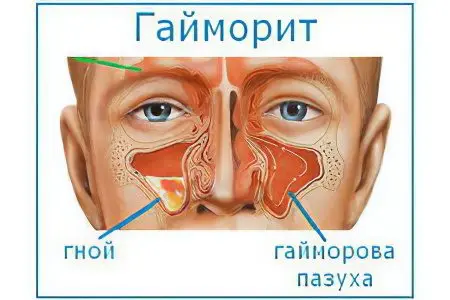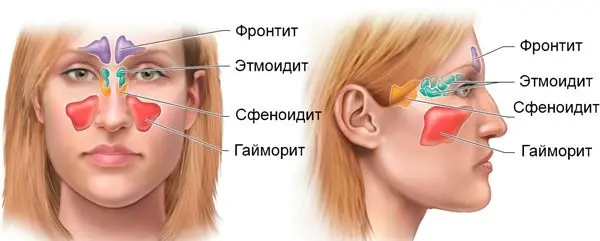Contents
Very often, people, having discovered the first signs of rhinitis, accompanied by weakness and loss of efficiency, do not pay due attention to this, believing that this mild form of a cold will pass on its own. Sometimes behind such seemingly frivolous symptoms, a very dangerous disease can be hidden, which, if not properly treated, has various side effects and complications.
What is sinusitis?

Sinusitis is an inflammation of the paranasal sinuses. Almost always it appears due to repeated deep rhinitis or colds, which were badly and dishonestly cured. But, in addition to colds and runny nose, neglected teeth, especially the upper ones, are another reason. The nose is blocked and mucus begins to accumulate inside. After that, pus begins to stand out.
The usual symptoms of sinusitis are loss of smell, heaviness in the head, pain in the temples and bridge of the nose, a fairly high temperature – in the range of 37–38 ° C. But, besides all this, a person’s memory worsens, working capacity decreases and fatigue increases.
It should be noted that if you do not start treating sinusitis at the initial stage, then it will develop into the next, purulent stage. As a result, you will develop other serious diseases.
In the acute course of the disease, the thin mucous membrane that covers the maxillary sinuses becomes inflamed. A negative effect is also exerted on the blood vessels located in this area, as well as on the connective tissue. When sinusitis passes into the chronic stage, damage to the bone walls of the maxillary sinuses and submucosa is observed. Sinusitis affects people of any age group. This disease develops regardless of the gender of patients. According to statistics, which can be found on specialized Internet resources, as well as in the media, the peak of sinusitis occurs in the autumn and winter seasons. In early spring, exacerbations of this disease also occur.

Causes of sinusitis
As a rule, the cause of sinusitis is an infection that enters the nasal cavity through the blood or when breathing. There are several underlying conditions that interfere with nasal breathing. This is a curvature of the nasal septum, vasomotor rhinitis, hypertrophic rhinitis (enlarged turbinates), in children – adenoids, allergic diseases of the nose.
Also, the cause of sinusitis can be disorders of the immune system, which lead to long-term chronic diseases, parasitosis, allergic conditions, etc., as well as untimely or improper treatment of the common cold, acute respiratory infections, rhinitis, which causes sinusitis as a complication.
When people take swabs from the nose during a physical examination, as a rule, a so-called staphylococcus aureus is found in a person, which lives in a person’s nasopharynx for a long time. The latter, if he had not been examined, would not have known that he was a carrier of bacteria. For a long time, these bacteria may not cause serious damage to health. But even with a common cold, staphylococcus aureus can become more active and show its pathogenic properties.
Modern medicine has identified numerous causes of sinusitis:
injury to the mucous membrane of the maxillary sinuses;
penetration into the nasopharynx of viruses and pathogenic bacteria;
poorly treated runny nose;
advanced form of a cold;
prolonged stay in a room where the air is too dry and heated to a high temperature;
being in a draft;
inhalation of chemical fumes (usually this occurs in hazardous production);
neglected condition of the teeth and non-compliance with oral hygiene;
external impact of aggressive environments on the mucous membrane;
transferred influenza or SARS;
severe hypothermia of the body;
dysfunction of the secretory glands;
weakening of the immune system;
abnormal structure of the organs of the nasopharynx and secretory glands;
mechanical damage to the nasal septum (any physical impact, trauma, etc.);
growth of polyps and adenoids;
an allergic reaction of the body to various external stimuli;
dangerous diseases such as tuberculosis, fungal infection of the mucous membrane, radiation sickness, tumors, etc.
The use of various medications, in the form of drops, can cause nosebleeds to start. This is due to the fact that drugs are too strong an irritant for the mucous membranes and tissues of the maxillary sinuses, as a result of which blood vessels can burst and nosebleeds begin.
Symptoms of sinusitis in adults

Symptoms of sinusitis is the appearance of pain in a person in the nose and near the nasal region, which gradually increase. Pain is less pronounced in the morning, increasing in the evening. Then the patient begins to lose a specific place with unpleasant sensations and his head begins to hurt. If the process is one-sided, then the pain is noted on one side.
The tone of the patient’s voice becomes nasal, stuffy nose, breathing through the nose is difficult. Alternate congestion of the right and left halves of the nose is possible.
Also, the patient is constantly tormented by a runny nose. Mucous (clear) or purulent (yellow, green) discharge from the nose is observed. This symptom may not be present if the nose is severely blocked.
Patients have a fever: sometimes it reaches 38 ° C, and sometimes higher. This temperature occurs in people who are sick with acute sinusitis. If the process is chronic, then high temperature rarely appears. Patients experience malaise, which is expressed by fatigue, weakness, patients refuse food, sleep is disturbed.
The disease of sinusitis is accompanied by certain symptoms:
the appearance of mucous discharge from the nose (over time, particles of pus may be present in them);
nasal congestion;
memory impairment;
a feeling of strong pressure in the region of the nose, which increases when the head is tilted;
sleep disturbance;
labored breathing;
loss of working capacity;
fatigue;
fever (often the temperature can rise to 40 ° C);
development of prolonged rhinitis, tonsillitis, pharyngitis;
the appearance of chills;
lethargy, weakness and general malaise;
frequent bouts of coughing;
pain in the nose, spreading to other parts of the body (forehead, gums, eye sockets, etc.);
severe headaches, aggravated even with slight turns of the head;
loss of appetite (both complete and partial)
Sinusitis of any kind is mainly treated with the help of conventional pharmacotherapy, which the doctor selects at the consultation. Washing of the paranasal sinuses (without a puncture) is carried out only with severe pain or profuse discharge of pus.
Laser therapy is also carried out to eliminate inflammation and enhance the effect of drug treatment. The course of treatment is from two weeks to two months.
Temperature with sinusitis
Sinusitis is often accompanied by a high temperature, which indicates the beginning of the inflammatory process. Thus, the human body reacts to the appearance of an infection, the toxins of which cause general intoxication. At different stages of sinusitis, significant temperature fluctuations can be observed. The acute form of this disease is accompanied by intense fever. In the case when sinusitis has passed into the chronic stage, patients may experience a slight increase in temperature, or a complete absence of heat.
If bacteria that affect the nasopharynx area join a progressive infectious sinusitis, then the patient may have a fever. The allergic form of sinusitis can take place at normal or slightly elevated temperatures. In elderly people with sinusitis, there is almost always a slight increase in temperature.
Scientists from around the world, when conducting research on this disease, came to the conclusion that various factors directly affect the temperature course of sinusitis:
age of the patient;
features of the body;
the state of the immune system;
parallel development of other diseases, etc.
Other signs of sinusitis

With the progression of sinusitis, patients may experience other signs of this disease:
partial or complete loss of smell;
the appearance of swelling in the nose, eyeballs and cheeks;
change in the tone of the voice (the appearance of nasality);
increased lacrimation;
the appearance of bad breath and sinuses;
unpleasant aftertaste after each meal;
increased sweating, etc.
What color is snot with sinusitis?
Sinusitis in most cases is accompanied by copious discharge from the sinuses (very rarely, this disease occurs without external signs). This is due to the fact that against the background of a strong inflammatory process in the maxillary sinuses, a strong accumulation of snot occurs, into which pus or blood clots are mixed in at later stages of the course of the disease.
At each stage of sinusitis, the color of the snot changes, so that specialists, when carrying out diagnostic measures, can determine the phase of the disease with high accuracy and prescribe the correct and effective treatment. The color of the snot and their consistency make it possible to determine the form and order of the inflammatory process that develops in the maxillary sinuses.
Currently, there are three main shades of snot that appear against the background of the development of sinusitis:
White color;
yellow-green color;
green color.
The appearance of white snot is observed at the initial stage of development of sinusitis. Mucous discharge of white color, thick consistency, may indicate the beginning of the patient’s recovery stage. Green snot indicates a strong inflammatory process in the maxillary sinuses. When a yellow tint appears in green snot, it can be confidently stated that sinusitis is in an acute form of the course of the disease and requires urgent intervention by specialists. A yellow tint is a sign of the appearance of pus particles in the snot.
The most severe form of sinusitis is accompanied by snot, in which there are blood streaks and small clots. The patient needs emergency medical care to avoid unpleasant consequences and complications that may develop with untimely medical treatment of severe sinusitis.
With the progression of sinusitis, some patients may periodically bleed from the nose. This phenomenon can be explained by an overdose of drops from rhinitis, or a previous injury in which the nasal septum was damaged. Nosebleeds can also indicate pathological changes in the mucosa and tissues of the maxillary sinuses that occurred against the background of the progression of sinusitis.
Video: causes of sinusitis, treatment methods
совершать длительные прогулки на свежем воздухе (предпочтение отдавать парковым и лесным зонам);
делать дыхательные упражнения, которые способствуют нормализации носового дыхания;
при проявлении первичной симптоматики ринита необходимо принимать меры (делать массаж, промывать носовые проходы, использовать специальные капли и другие лекарственные препараты);
перейти на здоровое питание, пересмотреть свой ежедневный рацион и ввести в него только полезные продукты;
полностью отказаться от вредных привычек, которые наносят непоправимый вред человеческому организму;
своевременно лечить любые заболевания, на фоне которых может развиться гайморит;
бережно относиться к своему здоровью, стараться не подвергать организм переохлаждению;
при первичных проявлениях аллергии следует незамедлительно обратиться к врачу и пройти курс медикаментозного лечения;
при наличии врождённой или приобретённой аномалии носовой перегородки необходимо обратиться в медицинское учреждение, в котором специалисты хирургическим способом исправят дефект.









